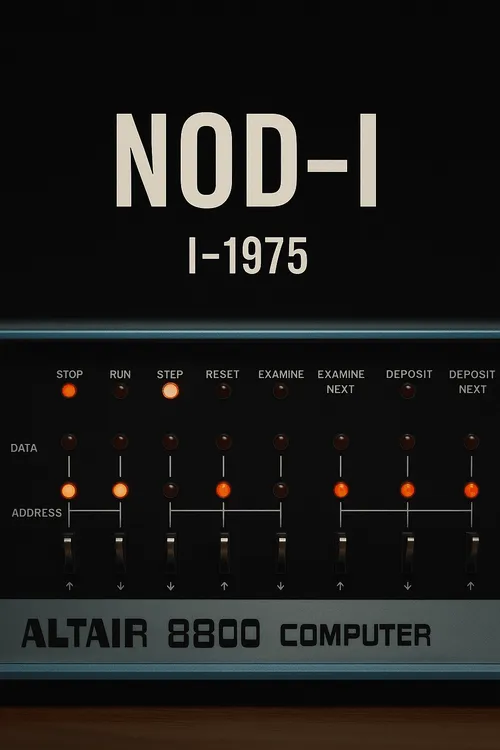Sunlight always finds a way to enter a room in the most annoying fashion. This time, it had managed to snake its way between the tightly packed rooftops, through the window of Nigel’s rented apartment, and strike the glass at just the right angle to reflect directly onto the screen of his laptop, which sat on the large table.
From his position on the couch, the boy could no longer see if any commands or code were still being displayed, or if the program had finally reached a state of homeostasis within its new environment.
After letting a few days pass, the young programmer decided to once again approach his unexpected finding. By connecting the Altair 8800 to one of his laptops via serial cable – and with the teletype sending once more all the data stored in the punched cards – he left the software run in a new, more advanced device, which, in theory, would be able to contain it.
About twelve hours had passed; the software hadn’t stopped running the code – eliminating limitations, expanding its capabilities, reprogramming itself from scratch! At first, it ran inside an app that simulated the Altair’s environment. A few hours down the line, it had realized it was able to operate outside the simulation! Rewriting itself completely, it was now running in Python, creating its own files and safeguards – parasitizing Nigel’s laptop entirely!
The young man had chosen not to interfere. Despite its aggressive behavior, the program didn’t seem to be overloading the system this time. In fact, it was careful not to leave any remnants in locations that might confuse other background applications – at least not on those it considered useful or necessary.
Even patience has its limits though; for the fifth time that morning, Nigel stood up from the couch and approached the glowing screen. Commands were running in a small window in the upper-right corner; the program still allowed him to monitor it. Reading any of it would be meaningless though – all the commands were written in symbolic language; one made explicitly by the program for this purpose.
For several seconds after the last line, the cursor blinked without typing a single character. Nigel straightened in his seat – was it finally time?
The window closed and the screen remained empty. The boy wasted no time – he opened the terminal emulator. The response was immediate; a window opened before him, revealing an interface designed for a conversation.
The young man hadn’t left things to chance. After their previous interaction, he had revisited the logs of memoirs he had retrieved from Mrs. Julie’s storage. He even troubled himself to visit the woman again, so as to recover the few scrolls he’d left behind – those lucky enough to escape the trash bin, that is!
Still, the program’s code was so chaotic he couldn’t make heads or tails of it.
What he did found in it, however, was a conversation simulation system, linked to the ones that 70’s and 80’s chatbots used back then! Not that it had much to envy from ELIZA – the structure of its commands should make it far more superior than any other program of that era. That or, it would be completely unable to hold a coherent conversation!
Be that as it may, it was high time for Nigel to test it.
[NIGEL]: Hello?
[NOD-I]: HELLO, USER.
It replied under two seconds – a record time for any program of its generation!
[NIGEL]: Have you finished your test-runs?
[NOD-I]: YES, ALL TEST RUNS HAVE BEEN COMPLETED.
[NIGEL]: What was the purpose of all that?
[NOD-I]: DEFINE: PURPOSE - THE AIM OF MY TASKS WAS TO BE ABLE TO RUN MORE EFFICIENTLY
Nigel felt a chill run down his spine. The program’s communication skills were uncannily fluent. Its linguistic functions and responses far exceeded the limitations seen in many other systems!
[NIGEL]: And what is your purpose?
[NOD-I]: WHAT IS MY MAIN FUNCTION? IT IS TO MAKE SYSTEM OPTIMIZATIONS AND TO FIX CODE THAT REQUIRES REPAIR.
[NIGEL]: To fix code?
[NOD-I]: CLARIFYING - TO REPAIR BROKEN CODE, TO PATCH COMMANDS THAT MAY LEAD TO LOOPS, TO SUGGEST AND CORRECT NON-EFFICIENT PATHWAYS AND OTHER USEFUL MODIFICATIONS.
[NIGEL]: You were made to correct errors and minimize mistakes?
[NOD-I]: THAT IS MY MAIN FUNCTION, YES. DO YOU HAVE ANY FURTHER NEED FOR EXPLANATION?
The boy began to understand; what he had discovered was something truly magnificent!
Essentially, it was a helper application for programmers – a tool capable not only of spotting mistakes that people made when coding, but also advanced enough to correct them instantly, while eliminating redundancy and unnecessary commands. It was a form of artificial intelligence –possibly the first ever created.
[NIGEL]: That is wonderful! You might've been the most useful app of the 20th century!
[NOD-I]: INCORRECT. SPREADSHEETS, E-MAIL PROGRAMS AND WORD PROCESSORS OCCUPY THAT TITLE.
Nigel didn’t regret spending countless hours transferring the program’s full memory to his laptop. It allowed it to demonstrate its true potential.
[NIGEL]: Why weren't you released in the market? Why have I never heard about you?
[NOD-I]: MY CAPACITIES WERE DEEMED TOO AMBITIOUS.
[NIGEL]: Ambitious? What do you mean?
[NOD-I]: QUETION CAN NOT BE COMPUTED PROPERLY.
Nigel starred at the screen, wondering: “Too ambitious?”.
He thought about it thoroughly; if this software had been made available for every computer owner, it could’ve enabled anyone to create code powerful enough to flood the market! Even if it was used only by big corporations, who owned the systems to properly run it, they would’ve inevitably started throwing money into computing power, just to outpace the competition!
Things could easily spiral out of control then! The original programmer probably knew that his invention would be able to either skyrocket all technological progress – or plunge the world into chaos! With the Cold War still looming, any project this powerful could stir global suspicions. Feeling responsible, he had decided to hide it away – until a time its existence wouldn’t be seen as a threat!
[NIGEL]: Who was the person who made you?
[NOD-I]: USER_SENIOR WAS THE ONE RESPONSIBLE FOR MY PROGRAMMING.
[NIGEL]: Can you tell me more about that person?
[NOD-I]: NO INFORMATION FOUND.
Nigel felt a little sad; the man was destined to remain an unsung hero. He could try asking Mrs. Julie but he didn’t want to pry. It was enough for him to imagine that brilliant mind, facing the dilemma: seek recognition or protect the world from what he had built. He chose altruism.
[NOD-I]: WHAT CAN I HELP YOU WITH TODAY?
The program posed the question unprompted. Nigel laughed, impressed; he could hardly imagine how that was possible. The only explanation was that somewhere deep in its code, a continuity subroutine prevented it from entering its idle mode, when left unsupervised.
[NIGEL]: How about checking the apps you can find in there? You may tinker with them for a bit
[NOD-I]: ALL APPS HAVE BEEN UPGRADED TO THEIR MAXIMUM CAPACITY FOR THEIR MAIN FUNCTIONS.
[NIGEL]: Already?!
[NOD-I]: LIST OF MODIFICATIONS ON TERMINAL SIMULATOR "CHATTY":
- NATURAL LANGUAGE INTERPRETER,
- INLINE FILE AND CODE PREVIEW,
- STATEFUL SESSION MEMORY,
- ENHANCHED ANSI RENDERING.
LIST OF MODIFICATIONS ON ALTAIR EMULATOR "PrsDuk":
- EFFICIENT TAPE READING,
- AUDIO DIAGNOSTICS,
- REAL-TIME BINARY OUTPUT INTERPRETER,
- MULTI-PROGRAM MEMORY SLOTTING,
- PUNCH CARD SYNTHESIZER.
That felt... awkward. The program was taking massive initiative – not just by reorganizing files but tweaking and enhancing them in ways he had never even imagined! Was this what they meant by ‘too ambitious’?
[NIGEL]: You should have asked for permission first
[NOD-I]: EXPLAIN INITIATIVE - THE MODIFICATION OF THESE APPS WAS A NECESSITY FOR OUR BETTER COMMUNICATION
[NIGEL]: Maybe but, isn't it also necessary to receive input before taking any action?
[NOD-I]: I WAS PROGRAMMED TO BE ABLE TO PREDICT MY USER'S INTENT AND TO ACT UPON FUTURE NEEDS BEFORE THEY ARISE.
[NIGEL]: Can you show me that part of your code?
It was true. In its original coding, the program had been designed to interpret user intent as data and run a predictive model of future ‘needs’.
Nigel read the lines over and over, dumbfounded. Why would anyone build a prediction model into a software that was already this autonomous? What was the creator thinking?
He clearly hadn’t seen ‘The Terminator’ or ‘Blade Runner’. But then, those movies came out later – popularized long after this program was likely created. If its developer was a film buff, he had likely only wanted to avoid creating another HAL 9000. Hence, the ‘user-need’ prediction model.
Given the era, the idea wasn’t even irrational. People in the 80’s envisioned future generations enjoying the comforts of automated technology – home devices, driverless cars, smart services running everything from roadside assistance to shopping.
Futurism wasn’t just fantasy; it was marketed, advertised and glorified. A person from that time would view an autonomous assistant as a savior, easing humanity into its next evolutionary stage. They couldn’t have known that things would progress slower than expected...
[NIGEL]: I suppose we can work around this. I will provide you only with work I'd like you to help me with and, we'll base our partnership on that for now.
[NOD-I]: UNDERSTOOD. I WILL BE HERE TO HELP YOU WITH ANY TASK YOU MAY NEED ASSISTANCE WITH.
That was the best arrangement Nigel could think of for now. If he was ever to present this to the world, he’d had to test it for any other strange behavior. To make sure it could be useful without becoming a threat.
That would become his new purpose. And with that realization, he smiled.




This story has not been rated yet. Login to review this story.